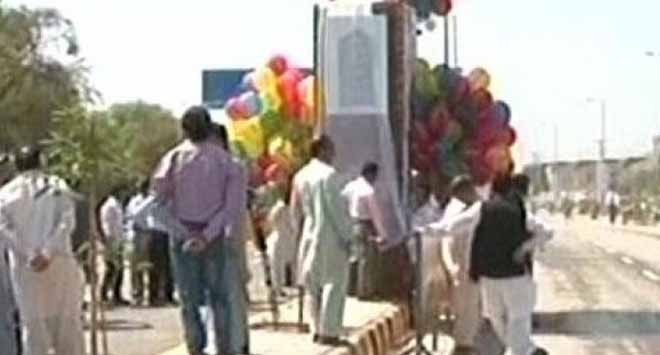

April 20 was a tragic day for some 40 children chasing the balloons released at the inauguration ceremony of a flyover near Walton in Lahore. After floating high in the air for a long time and travelling around eight kilometres, the balloons descended in a playground and caught fire under mysterious circumstances, resulting in burn injuries to these children.
One of the victims -- Naveed, who had suffered 32 per cent burns -- expired in Mayo Hospital six days later.
Following his death there were protests against the government, especially for its alleged failure to provide necessary medical treatment to the injured and compensation to the unfortunate burn victims’ families. The protest was covered extensively by the media and as a result the government machinery sprang into action to do the needful.
Compensations were paid and vows made to provide the injured necessary medical treatment. But this was not all that was required. There were certain questions which were, and still are, unanswered. For example what were the reasons that led to this tragic incident? Has responsibility been fixed on anybody and how can similar incidents be avoided in the future?
Zia Awan, President of Madadgar National Helpline -- the Karachi-based rights organisation which took up the matter through its Lahore office -- is not fully satisfied with the progress of the case.
Awan says the Punjab government has not carried out proper investigations and made the findings public. There has been no disclosure about the nature of the gas filled in these balloons or about the chemical analysis of the material used in balloons. This demand is relevant amid suspicions that a highly inflammable gas, hydrogen, was filled in the balloons instead of the recommended helium which is safer but expensive.
Awan insists an FIR should be lodged without delay and those responsible for the tragedy should be taken to task. No doubt this incident is an accident and the people who arranged these balloons had no intention to harm these children, but they are answerable for show of sheer negligence, he says.
Zia appeals to the government to totally ban the use of gas-filled balloons and make arrangements to provide alternative livelihood to balloon sellers -- because the gas cylinders they carry along in streets are walking bombs and can explode any time. Several cases of cylinder blasts and injuries caused by these have been reported in the past, he adds.
Qamar Abbas, whose three brothers got injured in the incident, says the government machinery which was too slow in responding has become highly efficient after Naveed’s death. Fourteen children, who had been discharged against the will of their relatives, have been readmitted to the hospital. Besides, he says, "the government has set up two makeshift wards close to the homes of the injured and installed LCDs, air-conditioners and generators. They will be treated here till the time they get well."
In addition, Abbas says, the government has given Rs550,000 as compensation to the family of the deceased and Rs200,000 each to the injured.
Amid allegations of poor response on part of the government, Tariq Zaman Khan, Staff Officer to the District Coordination Officer (DCO), clarifies that the district government responded efficiently to the emergency and soon after the incident its officers visited the residences of injured patients in both the villages. The purpose, he says, was to verify their particulars and to provide them free medical treatment.
On precautions to avoid similar incidents in future, he says, gas-filled balloons have been there for ages but it is the first time that such an accident has taken place. It will have to be seen what caused this accident, he adds.
PML-N Media Advisor and MPA Khawaja Imran Nazir, who has liaised with the families of the injured, says he had met the deceased child Naveed at Mayo Hospital a day before his death. He was complaining about pain in his chest and it seemed he was having difficulty breathing.
On the cause of this tragedy, Nazir says there are suspicions that the balloons caught fire after being touched by a live cigarette or some other burning object. There’s a possibility that someone having a cigarette in his hand tried to catch a balloon. Some vendors of dry, roasted corn where at the site of the incident too.
Nazir says this was the first accident of its kind and the scale of damage was high as hundreds of balloons were tied to each other. Had they been released one by one, the situation would have been different, he thinks.
Zia Awan is not comfortable with the idea of one-time monetary compensation for the affected. However, the government, he thinks, can announce a rehabilitation plan for the injured children. He says it will take these children a long time and continuous medical treatment including corrective surgery to come back into the mainstream.
Awan says that Madadgar National Helpline has filed a complaint about this accident with Child Commissioner at Punjab Ombudsman office. The office has issued notices to the concerned departments but progress on the case is a bit slow. In case the helpline believes the collective rights of these children are being compromised, it would go for a constitutional petition in the high court, he vows.
While many demand total ban on this activity, Khawaja Salman Rafiq, Advisor to Punjab Chief Minister on Health, has announced that the government would shortly launch an awareness campaign on the hazards of gas balloons and what to avoid while handling them. This implies there is no immediate plan to ban their use and the government wants to guide people on safety tips. But what is needed the most is that the inquiry report based on forensic reports should be made public.